Explore Ajman - United Arab Emirates (UAE) Travel, Asia
Ajman, the smallest of the seven emirates, might not be as famous as Dubai or Abu Dhabi, but that’s what makes it special. Tucked away on the Arabian Gulf, Ajman is a serene, laid-back destination perfect for those who want to escape the hustle of city life. Its stunning coastline, rich cultural heritage, and welcoming locals offer a uniquely Emirati experience. This hidden gem of the UAE offers travelers a chance to unwind while still enjoying all the perks of a vibrant, growing emirate.
Population: Approximately 500,000 in 2020.
Economy: Ajman’s economy thrives on diverse sectors including real estate, manufacturing, trade, and tourism. Its strategic location and free zones attract investment, making it a growing hub for small and medium enterprises.
Landmarks: Famous for the Ajman Museum, Al Zorah Nature Reserve, and Ajman Beach.
United Arab Emirates
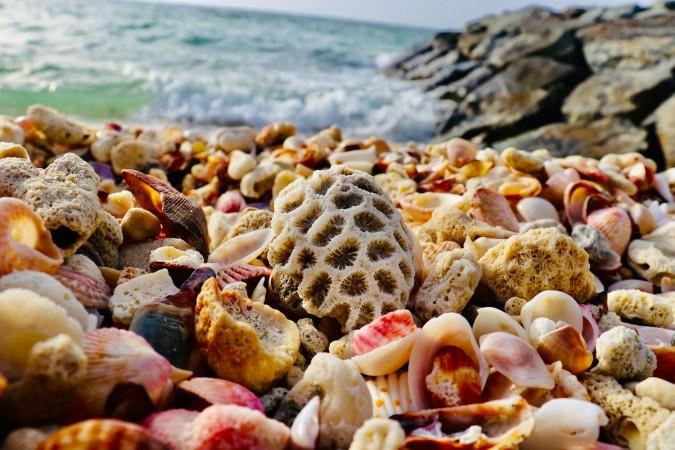
Overview of Ajman
History & Culture Influence
Ajman’s history dates back to centuries before the formation of the United Arab Emirates. Historically, the emirate thrived as a center for fishing, pearling, and boat-building. Its strategic location along the Arabian Gulf helped shape its development, and today, you can still see traces of its seafaring past. In addition, Ajman has also maintained a strong connection to its cultural roots with the influence of Bedouin traditions still visible in the daily life of the locals. You’ll notice the distinctive Emirati architecture, traditional markets, and the ever-present falconry—a symbol of the UAE’s heritage.
Interaction with the Locals
Ajman, the smallest emirate in the UAE, has a population of almost 500,000 people as of recent estimates. The majority of the population consists of expatriates from various countries, but the local Emirati citizens make up a significant portion as well. Ajman’s citizens, known for their warm hospitality, are deeply rooted in their traditional culture, maintaining close ties to their heritage while embracing the modern developments of the emirate.
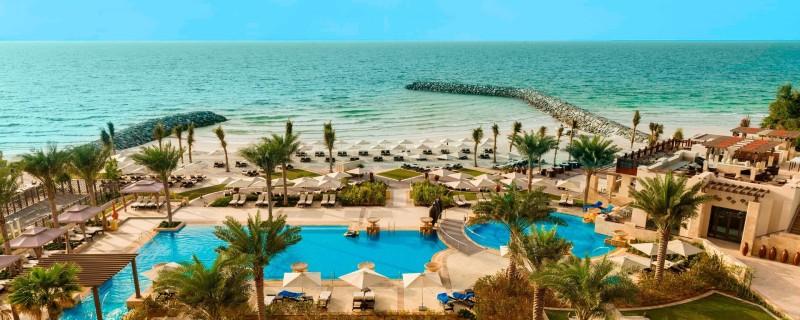
Ajman Beach - © Marriott
Top Attractions in Ajman
Ajman Museum
The Ajman Museum is one of the most important cultural landmarks in Ajman which housed a beautifully restored 18th-century fort. This museum showcases artifacts, manuscripts, and traditional weapons, offering visitors a deep dive into the emirate’s past. The museum brings the region’s fishing and pearling history to life, making it a must-see for those interested in the UAE’s heritage.
Al Zorah Nature Reserve
For nature lovers, Al Zorah Nature Reserve is a haven of biodiversity. This protected area is home to over 60 species of birds, including flamingos, and offers visitors a chance to experience the UAE’s natural beauty. You can explore the mangroves by kayak or enjoy a leisurely boat ride while admiring the lush landscape.
Ajman Beach
Ajman’s coastline stretches for miles, with Ajman Beach being one of the most popular spots for both tourists and locals. Unlike the crowded beaches of Dubai, Ajman’s beaches are quieter and offer the perfect setting to relax, swim, or try your hand at water sports. With crystal-clear waters and clean white sands, it’s a tranquil retreat for those looking to unwind.
Ajman Dhow Yard
The Ajman Dhow Yard represents the emirate's maritime tradition and its preservation effort. It’s the world’s largest dhow-building center, where traditional wooden boats are still handcrafted using age-old techniques. A visit here provides a rare opportunity to witness master craftsmen at work, constructing vessels that have sailed the Arabian Gulf for centuries.
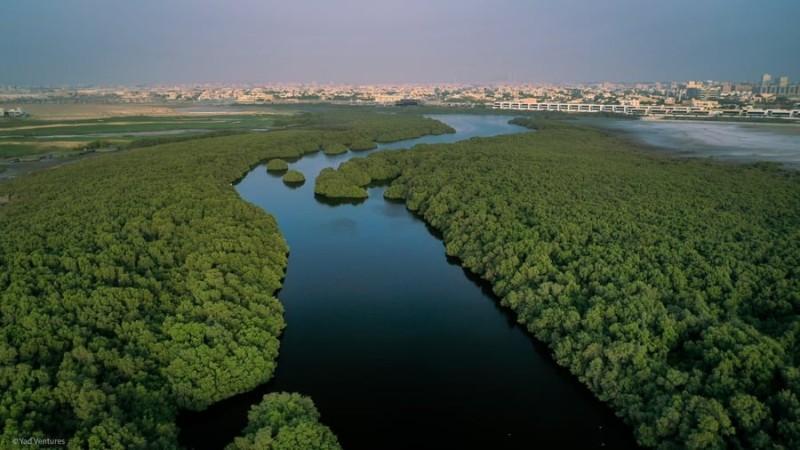
Al Zorah Nature Reserve - © Green Future Project
Must-Try Dishes in Ajman
Ajman’s traditional dishes offer a rich blend of traditional Emirati flavors and regional influences, with dishes that highlight the use of spices, fresh ingredients, and local produce.
- Machboos: One of the most iconic dishes in Ajman, made with lamb, chicken, or fish. It’s seasoned with saffron, turmeric, cardamom, and other fragrant spices, giving it a deep, aromatic flavor. Machboos is a comforting dish that offers a true taste of Emirati home cooking.
- Harees: Harees is a simple yet cherished dish prepared from wheat and beef that is slow-cooked to achieve a porridge-like consistency. It is especially popular during Ramadan. Harees has a mildly seasoned flavor and is often served during festive occasions.
- Luqaimat: Luqaimat is a must-try dessert when you visit Ajman. Drizzled with date syrup or honey and sprinkled with sesame seeds, Luqaimat are a popular snack during Ramadan and festive occasions, though they are enjoyed year-round.
- Jasheed: Made from shredded, spiced baby shark or fish, Jasheed is cooked with a blend of spices, onions, and garlic, and served with rice or bread. It’s a dish that highlights the region's maritime history and the Emiratis’ expertise in seafood cuisine.
- Madrouba: Madrouba is a comforting Emirati dish made by cooking rice, chicken (or fish), and spices until they form a smooth, creamy texture. The name comes from the Arabic word for "beaten," as the ingredients are stirred continuously until the dish becomes almost porridge-like.

Machboos - © The Daring Gourmet
Festivals & Local Celebrations
Ajman International Urban Photography Festival
One of Ajman’s most celebrated events is the Ajman International Urban Photography Festival. This annual event attracts photographers from across the globe, who capture the emirate’s natural beauty, modern architecture, and rich culture through their lenses. It’s a vibrant celebration of art and photography, providing tourists with a unique opportunity to explore Ajman’s charm in a creative and interactive way.
UAE National Day Celebrations
The UAE National Day, held on December 2nd, is a big event in all emirates, including Ajman. The city comes alive with parades, fireworks, and traditional performances, such as Al-Ayyala (a traditional Emirati dance). It’s a joyful occasion that showcases the pride and unity of the Emirati people, and tourists are welcome to join in the celebrations.
Ramadan and Eid Celebration
Ramadan, the holy month of fasting, is a special time in Ajman, filled with spiritual reflection and cultural traditions. While tourists should be mindful of fasting customs, it’s a great opportunity to experience Iftar—the evening meal that breaks the fast. Restaurants across the city offer special Iftar buffets, and visitors can enjoy traditional Emirati dishes in a festive atmosphere. Following Ramadan, the Eid al-Fitr celebrations are marked by family gatherings, feasts, and cultural events that tourists can also enjoy.

UAE National Day Celebrations - © Happy Hearts Nursery
What to Do in Ajman
- Beach Activities: Ajman’s coastline is one of its major attractions, and there are plenty of activities for water enthusiasts. Popular activities include jet-skiing, paddleboarding, and snorkeling in the calm, clear waters of the Arabian Gulf.
- Golfing at Al Zorah Golf Club: Golf lovers will be thrilled by the stunning Al Zorah Golf Club, a world-class 18-hole championship course designed by Nicklaus Design. Surrounded by the lush Al Zorah Nature Reserve, the course offers breathtaking views and challenging play, perfect for both seasoned golfers and those new to the sport, with top-notch facilities and coaching available.
- Wellness Retreats: Ajman is home to some of the UAE’s finest wellness and spa resorts. Ajman Saray and The Oberoi Beach Resort, Al Zorah provide a wide range of holistic treatments, including traditional Arabic therapies, massages, and beauty treatments that help you relax and rejuvenate.
- Kayaking and Bird Watching at Al Zorah Nature Reserve: Known for its mangroves and rich biodiversity, the reserve is home to over 60 bird species, including flamingos. Visitors can explore the serene waters by kayak, enjoying both the tranquility of the mangroves and the vibrant wildlife around them.
Shopping in Ajman
- Ajman City Centre: Ajman City Centre is the largest and most popular shopping mall in the emirate. It features a mix of international brands, local stores, and a variety of dining options. Whether you're looking for fashion, electronics, or souvenirs, this mall has something for everyone.
- Ajman Fish Market & Souks: For a more traditional shopping experience, visit the Ajman Fish Market. You can watch fishermen bring in their daily catch, haggle with vendors, and even have your purchase grilled on the spot. Nearby, you’ll find local souks selling spices, textiles, perfumes, and handcrafted goods, offering a true taste of Emirati culture.
- Al Nakheel Oasis: Al Nakheel Oasis is another great spot for shopping, known for its charming markets where you can find unique souvenirs. From traditional abayas to artisanal crafts, this market is a treasure trove for travelers looking for authentic Emirati products.
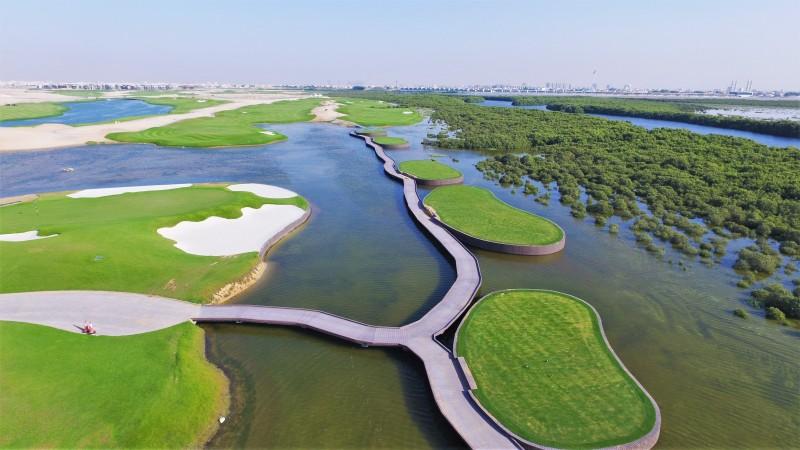
Golfing at Al Zorah Golf Club - © Al Zorah Golf Club Official account (X/ @AlZorahGolfClub)
Weather in Ajman: Best Time to Visit
Spring in Ajman
Spring brings rising temperatures, with daytime highs ranging from 28°C to 35°C (82°F to 95°F). The weather remains pleasant enough for beach activities and sightseeing, though the heat starts to intensify as summer approaches. Early spring is a good time to visit if you prefer fewer crowds and still comfortable temperatures. Outdoor activities are best enjoyed in the mornings and evenings when it's cooler.
Summer in Ajman
Temperatures soar above 40°C (104°F), often accompanied by high humidity, making summer in Ajman a challenge for those unaccustomed to intense heat. Outdoor activities are generally avoided during the daytime, and most visitors opt for indoor experiences such as shopping, museums, or spa treatments. Despite the extreme weather, summer is considered off-peak, so you’ll find significantly lower hotel rates and less crowded tourist spots.
Autumn in Ajman
Autumn marks the transition from the scorching summer to cooler winter months. In October, temperatures begin to drop, ranging from 30°C to 36°C (86°F to 97°F). The humidity also decreases, making outdoor activities more enjoyable as the season progresses. This is an ideal time for travelers seeking good weather without the crowds of the peak winter season.
Winter in Ajman
Winter in Ajman is the most pleasant time of the year, with temperatures ranging between 20°C and 28°C (68°F to 82°F). This season offers mild, comfortable weather, perfect for outdoor activities, beach outings, and sightseeing. The cooler climate attracts many tourists, making it the peak travel season. If you're planning to visit during this period, booking your accommodations in advance is recommended due to the influx of travelers.
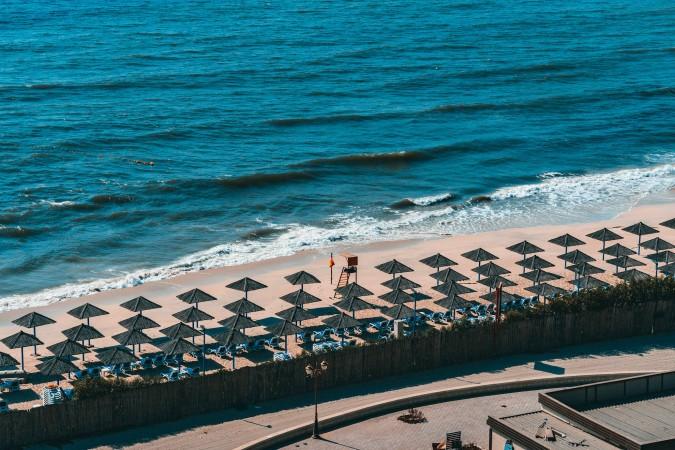
Relax by the Ajman Beach - © Dovlet Hojayev
Essential Travel Information
Getting Around Ajman
- Taxis: Taxis are easily available across the emirate, with metered fares that are reasonably priced when compared to other parts of the UAE. You can easily hail a taxi on the street or arrange for one through a ride-hailing app like Uber or Careem.
- Buses: Ajman has a modest public bus network that connects the city to nearby emirates like Dubai and Sharjah. While the bus system is limited within Ajman itself, it offers a budget-friendly option for inter-emirate travel.
- Walking and Cycling: Ajman is a relatively small city, and many of its attractions are within walking distance of each other. In cooler months, walking is a pleasant way to explore the city’s beachfront, souks, and historical sites. Cycling is also an option, with a few rental services available, especially near the coast.
ATM & Banking Services
Ajman offers convenient access to ATMs and banking services throughout the emirate, especially in major commercial areas, shopping malls, and hotels. ATMs widely accept international cards, allowing visitors to easily withdraw UAE dirhams (AED). Most hotels provide currency exchange as well, although it's advisable to compare rates. Credit cards are commonly accepted at most restaurants, shops, and hotels, but it’s a good idea to carry some cash for smaller vendors or local markets where cash payments are preferred.
Where to Stay in Ajman
- Luxury Resorts: Ajman is home to a range of luxury resorts, ideal for those seeking a high-end beachfront experience. These resorts offer stunning ocean views, private beaches, and a wealth of amenities such as fine dining, spa services, and recreational activities like water sports and golf.
- Mid-Range Hotels: These establishments offer spacious rooms, great service, and easy access to both the beach and key city attractions. Mid-range hotels are an excellent choice for families, business travelers, or couples wanting a relaxing stay without overspending.
- Budget-Friendly Stays: These lodgings provide clean, comfortable rooms and modern amenities at a lower price point, making them ideal for long-term visitors or those looking to explore the city on a budget. Despite the lower cost, you’ll still find all the essentials for a pleasant stay.
Articles for you

Explore Yala National Park - Sri Lanka Travel, Asia
Tucked away in Sri Lanka’s southeastern corner, Yala National Park is where wild nature meets deep tradition. Known worldwide for its leopard population, the park is also home to elephants, sloth bears, crocodiles, and hundreds of bird species. Beyond wildlife, Yala opens doors to a cultural landscape dotted with ancient temples, Buddhist ruins, and coastal villages. For travelers seeking more than just a safari, Yala offers a chance to explore eco-tourism, local communities, and sacred heritage sites.
Population: The Yala National Park area doesn’t have a human population.
Economy: The economy around Yala National Park thrives on a blend of eco-tourism, agriculture, and local services. Safari tours, eco-lodges, and cultural experiences drive steady income for nearby towns like Tissamaharama and Kataragama, supporting thousands of families.
Landmarks: Famous for Block I of Yala and wildlife encounters, including elephants, sloth bears, crocodiles, and exotic bird species.

Explore Galle - Sri Lanka Travel, Asia
Nestled on Sri Lanka’s southern coastline, Galle is a vibrant city where history meets the sea. Its cobbled streets, colonial architecture, and serene beaches make it a must-visit destination for travelers seeking a blend of culture, adventure, and relaxation. A UNESCO World Heritage site, Galle captivates visitors with its Dutch Fort, bustling markets, and friendly locals. Whether you’re exploring the ramparts at sunset or savoring fresh seafood by the shore, Galle promises an unforgettable journey into Sri Lanka’s heritage.
Population: Approximately 113,000 in 2023.
Economy: Galle’s economy thrives on tourism, trade, and fisheries. The city’s historic fort, colonial architecture, and coastal charm draw thousands of international visitors each year, making tourism its main economic driver. Fishing remains vital for local livelihoods, supplying fresh seafood across the region.
Landmarks: Famous for the Galle Fort, Dutch Reformed Church & Maritime Museum, and Unawatuna Beach.

Explore Bentota - Sri Lanka Travel, Asia
Nestled along Sri Lanka’s southwestern coast, Bentota is a tropical paradise that blends golden beaches, vibrant culture, and thrilling adventures. Famous for its calm waters, luxury resorts, and scenic river estuary, Bentota has become a top destination for travelers seeking both relaxation and authentic experiences. From serene beach walks at sunrise to adrenaline-pumping water sports, this coastal town offers a perfect balance of leisure and exploration. With its proximity to Colombo and Galle, Bentota is easy to reach, making it an ideal stop for both short escapes and extended holidays.
Population: Approximately 37,000 in 2023.
Economy: Bentota’s economy thrives mainly on tourism, which drives local businesses such as hotels, restaurants, and wellness retreats. The town also benefits from fishing, coconut cultivation, and handicrafts like wood carving and batik textiles. Many residents rely on the growing demand for water sports and Ayurvedic treatments, making tourism the backbone of both income and employment in the area.
Landmarks: Famous for Bentota Beach, Bentota River Safari, and Kande Vihara Temple.

Explore Mirissa - Sri Lanka Travel, Asia
Mirissa is a charming coastal town on Sri Lanka’s southern shoreline. Known for its golden beaches, turquoise waters, and vibrant marine life, it has become a must-visit stop for travelers exploring the island. Many come for whale watching, surfing, and sunset views at Coconut Tree Hill, but Mirissa offers much more than postcard beauty. The fishing boats you see anchored by the bay carry generations of stories. Local traditions, delicious cuisine, and a laid-back rhythm of life shape every visitor’s experience.
Population: Approximately 4,700 in 2023.
Economy: Mirissa’s economy is largely shaped by its coastal location. Fishing has long been the backbone of local livelihoods, with generations relying on the Indian Ocean for income. In recent decades, tourism has become the main driver of growth, thanks to whale watching, surfing, and beachside hospitality.
Landmarks: Famous for Mirissa Beach, Coconut Tree Hill, and Parrot Rock Bridge.

Explore Nuwara Eliya - Sri Lanka Travel, Asia
Tucked away in the Central Highlands of Sri Lanka, Nuwara Eliya is often called “Little England”. With its rolling tea plantations, cool misty mornings, and colonial charm, this mountain town feels like a step into another world. Travelers come here to breathe fresh air, walk through flower gardens, sip the finest Ceylon Tea, and enjoy a pace of life far from the island’s busy cities. Whether you’re drawn by scenic landscapes, heritage architecture, or the warmth of its people, Nuwara Eliya is a destination that blends nature, culture, and history in perfect harmony.
Population: Approximately 781,000 in 2023.
Economy: Nuwara Eliya’s economy thrives mainly on tea production, as it sits in the heart of Sri Lanka’s central highlands, famous worldwide for Ceylon Tea. The city also benefits from a growing tourism industry, attracting visitors with its colonial charm, cool climate, and scenic landscapes.
Landmarks: Famous for Gregory Lake, Hakgala Botanical Garden, and Victoria Park.

Explore Sukau - Malaysia Travel, Asia
Nestled on the banks of the Kinabatangan River in Sabah, Malaysian Borneo, Sukau is a destination where wildlife, culture, and conservation come together. Known as one of Asia’s top spots for river safaris and eco-tourism, this quiet village offers a front-row seat to encounters with Bornean orangutans, pygmy elephants, proboscis monkeys, and exotic birdlife.
Population: Approximately 1,400 in 2019.
Economy: Sukau’s economy is shaped by its riverine location and natural resources. Traditionally, the Orang Sungai community relied on fishing, small-scale farming, and forest gathering for their livelihood. Today, the village has shifted toward eco-tourism, with river cruises, jungle trekking, and homestays providing income.
Landmarks: Famous for the Kinabatangan River cruises, Gomantong Caves, and Ox-bow lakes and wetlands.
